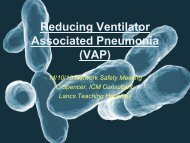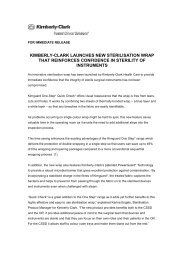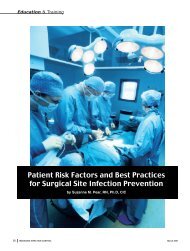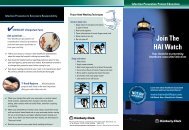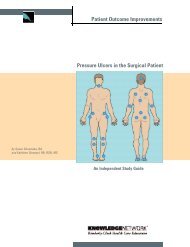Transforming Acute Care - HAI Watch
Transforming Acute Care - HAI Watch
Transforming Acute Care - HAI Watch
Create successful ePaper yourself
Turn your PDF publications into a flip-book with our unique Google optimized e-Paper software.
<strong>Transforming</strong> the <strong>Acute</strong> <strong>Care</strong><br />
Pathway in CMFT<br />
Dr Jane Eddleston
Background<br />
• No standardised way to perform clinical observations<br />
• No agreed monitoring policy<br />
• No assessment of workforce’s competency to<br />
undertake observations<br />
• EWS policy in place since 2000 but not embedded<br />
effectively in patient pathway of all in-patients<br />
• EWS policy which underpinned the pathway for acute<br />
illness recognition and response did not work<br />
• Late presentation of patients to critical care service<br />
• High cardiac arrest rate<br />
• Readmission rate to Critical <strong>Care</strong> >2%
NCEPOD 2005<br />
• All medical admissions to UK<br />
ICUs in June 2003<br />
• 21% of admissions to ICU<br />
were deemed avoidable<br />
• 40% were deemed not to have<br />
received prompt or<br />
appropriate treatment prior to<br />
admission<br />
• Suboptimal ward care<br />
contributed to 35% of ICU<br />
deaths
NPSA 2007<br />
• Review of “576 deaths<br />
that could be<br />
interpreted as<br />
avoidable”<br />
• “Clinical or<br />
physiological<br />
deterioration not<br />
recognised or not<br />
acted on”
Baseline data<br />
• 747 consecutive patients (MAU)<br />
• 20% of EWS were incorrectly calculated<br />
• 116/747 patients alerted: generated 567 alerts (EWS 3<br />
or more)<br />
• 47% EWS of 3<br />
• 30% EWS of 4<br />
• 23% EWS of 5 or above<br />
• 31% of patients with an EWS of 3 or above had a<br />
documented clinical response (16% for EWS 6 or<br />
more)<br />
• 65% of patients with an EWS of 3 or above continued<br />
to trigger
<strong>Transforming</strong> the Pathway<br />
• Monitoring Policy<br />
• Standards for the undertaking of observations<br />
• Documentation (electronic solution, accountability, paperless<br />
system)<br />
• Response (automated, response aligned to competency)<br />
• Skills and Knowledge of Workforce<br />
• Assurance of Competency<br />
• Accountability (Emergency Bleep meeting)
<strong>Transforming</strong> the Pathway<br />
• Monitoring Policy<br />
• Standards for the undertaking of observations<br />
• Documentation (electronic solution, accountability, paperless<br />
system)<br />
• Response (automated, response aligned to competency)<br />
• Skills and Knowledge of Workforce<br />
• Assurance of Competency<br />
• Accountability (Emergency Bleep meeting)
<strong>Transforming</strong> the Pathway<br />
• Monitoring Policy<br />
• Standards for the undertaking of observations<br />
• Documentation (electronic solution, accountability, paperless<br />
system)<br />
• Response (automated, response aligned to competency)<br />
• Skills and Knowledge of Workforce<br />
• Assurance of Competency<br />
• Accountability (Emergency Bleep meeting)
Observation Entry<br />
• Tabs for each data item to be<br />
entered<br />
• Designed for use by finger<br />
using intuitive “calculator”<br />
keypad<br />
• Data entered is validated<br />
against configurable EWS<br />
ranges
How does it work<br />
Ward View<br />
• Lists all patients on<br />
the ward<br />
• Current alerts<br />
highlighted<br />
• Overdue observations<br />
highlighted.
Ward Summary
Toughbook<br />
Not in use<br />
Power<br />
Camera<br />
Not in use<br />
Not in use<br />
Shortcut to Patientrack<br />
Shortcut to CWS<br />
To lock/ unlock device
<strong>Transforming</strong> the Pathway<br />
• Monitoring Policy<br />
• Standards for the undertaking of observations<br />
• Documentation (electronic solution, accountability, paperless<br />
system)<br />
• Response (automated, response aligned to competency)<br />
• Skills and Knowledge of Workforce<br />
• Assurance of Competency<br />
• Accountability (Emergency Bleep meeting)
Adult<br />
Patient<br />
Non-Clinical Staff<br />
Recorder<br />
Recogniser<br />
Primary Responder<br />
Communicationr<br />
Secondary Responder<br />
Tertiary Responder<br />
Critical care
-Developed to<br />
compliment NICE<br />
50<br />
- 75 <strong>Acute</strong> <strong>Care</strong><br />
Competencies<br />
-Designed to<br />
include all members<br />
of the workforce
Competency Group Non clinical Staff "Recorder" "Recogniser" "Primary<br />
Responder“<br />
Description of<br />
group role<br />
NICE Response<br />
Level<br />
call for help and<br />
recognition of illness<br />
recorder and<br />
interpretation within<br />
T&T protocol<br />
recognition and<br />
interpretation of<br />
observations<br />
primary response and<br />
intervention<br />
"Secondary<br />
responder"<br />
Secondary response<br />
and intervention<br />
Critical <strong>Care</strong><br />
Tertiary<br />
response and<br />
Critical care<br />
Low Risk Low Risk Low Risk Medium Risk High Risk<br />
Patients themselves<br />
Relatives<br />
Ward Clerks<br />
Ward Domestics<br />
Porters/support staff<br />
Trainee clinical staff<br />
Band 2-4 HCAs<br />
Band 5-6 Ward Nurses<br />
Band 6-8 Ward Nurses<br />
Physiotherapists<br />
FY 1 Doctors<br />
FY 2 Doctors<br />
ST 1-2 Doctors<br />
ST 3 to Consultant Doctors<br />
Hospital at night team<br />
Critical care outreach<br />
Critical care advanced practitioners<br />
Critical care ST1-2 Doctors<br />
Critical care ST 3 to Consl
Using technology to enhance acute care
Implementation of Patientrack<br />
• All observation sets complete<br />
• No summation errors<br />
• EWS policy determines time for next set of<br />
observations<br />
• Alerts sent to inform staff of next set of observations<br />
• Where responses have occurred all are within<br />
appropriate timeframe<br />
• Length of hospital stay for acute medical patients<br />
maintained at 5 days<br />
• Introduced other electronic software to the bedside<br />
• Roll-out in progress (~80 wards to be included)
Implementation of Patientrack: June to October 2010<br />
• EWS profiles differ in Medicine and Surgery<br />
• <strong>Acute</strong> Medical admissions ~21% of all observations 0<br />
~ 72% EWS 1-3<br />
~ 6% EWS 4-6<br />
• Surgery (Hepato-bilary Surgery)<br />
Monthly increase in EWS of 0<br />
~12 to 39% (ward 11), 25 to 60% (ward 12)<br />
Corresponding reduction in EWS 1-3 with time<br />
~77 to 54% (ward 11), 68 to 34% (ward 12)<br />
EWS 4-6 ~5 to 4% (ward 11), 3 to 1.5% (ward 12)
<strong>Transforming</strong> the Pathway<br />
• Monitoring Policy<br />
• Standards for the undertaking of observations<br />
• Documentation (electronic solution, accountability, paperless<br />
system)<br />
• Response (automated, response aligned to competency)<br />
• Skills and Knowledge of Workforce<br />
• Assurance of Competency<br />
• Accountability (Emergency Bleep meeting)
Emergency Bleep meetings<br />
• 351 cases discussed<br />
• 100 cases brought back for review<br />
• 8 cases outstanding<br />
• Classify cardiac arrests as potentially avoidable or not<br />
• Include potentially avoidable cardiac arrests on patient<br />
safety dashboard<br />
• Divisional Clinical Governance teams to be responsible<br />
for completing and monitoring successful<br />
implementation of these action plans<br />
• As Patientrack rolls out the tracking of events prior to a<br />
clinical event will be traceable and accountability will be<br />
clearly defined
Themes of EBM<br />
Medical cover 5%<br />
Other 20%<br />
Fluid Balance 8%<br />
Oxygen Policy 8%<br />
Other refers to:<br />
*Consultant Ownership<br />
(1%)<br />
oNIV issues (2%)<br />
oInappropriate patient<br />
placement (2%)<br />
oTransfer of patients<br />
(3%)<br />
oCommunication /<br />
handover (3%)<br />
oABG delay (3%)<br />
oDelay in medical<br />
attendance (3%)<br />
oAgency staff<br />
competency (3%)<br />
EWS 19%<br />
Observation Policy<br />
11%<br />
Documentation 10%<br />
DNAR Issues 9%<br />
Sepsis recognition and<br />
management 10%
Next steps<br />
• Continue with implementation<br />
• Continue education programme and assessment of<br />
competency in acute care<br />
• Use Patientrack data as basis for H@N handovers<br />
• Assess response times and reasons for non-response as<br />
more surgical wards come on board<br />
• Amend Patient safety dashboard to include :avoidable<br />
cardiac arrests; response times for EWS 4+; duration<br />
from last cardiac arrest<br />
• Consider if H@D team required to assist in response<br />
and intervention
• Transformation of <strong>Acute</strong> <strong>Care</strong> requires a multistranded approach<br />
• <strong>Acute</strong> <strong>Care</strong> is core business for the NHS<br />
• All clinical staff need to be engaged in <strong>Acute</strong> <strong>Care</strong><br />
• Identifiable Process Measures for the pathway need to be<br />
implemented<br />
• Responsibility for Clinical <strong>Care</strong> resides with senior medical and<br />
nursing staff<br />
• Organisations must ensure each individual clinician is accountable<br />
for their performance<br />
• Ultimate outcome measures for the pathway need to be published



